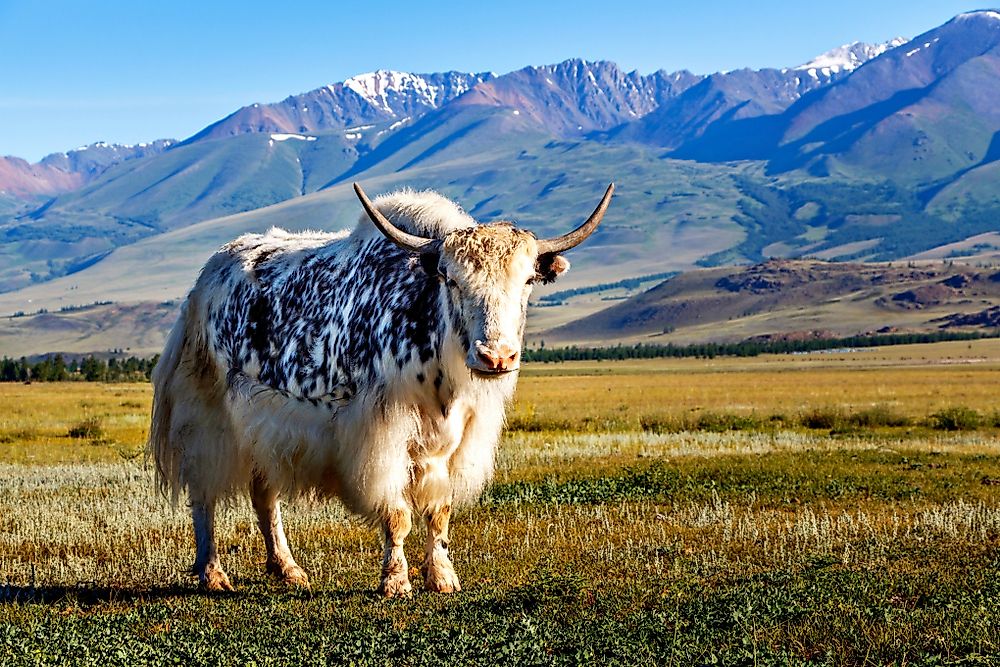10 Interesting Facts About Yaks

The yak is a large bovid that is found at high altitudes, mostly in the grasslands of the Tibetan Plateau. Yaks are also found as far north as Mongolia and Russia. Here are ten interesting facts about yaks:
Main Species
There are two main species of the Yak, namely, the wild yak (Bosmutus) and the domestic yak (Bosgrunniens).
Habitat
Wild yaks can live at altitudes of between 9,800 and 18,000 feet and can tolerate temperatures of up to -40 degree Fahrenheit.
Physical Characteristics
Yaks have a bulky frame, and short, thick legs. They also have a broad forehead, relatively small ears, and distinctive humps over their shoulders. Their tails are also unique as they resemble horsetails as opposed to bison or cattle tails. All yaks have horns with those of males sweeping out from their heads and curving forward. The diet of a yak consists of herbs, grasses, mosses, lichens, wildflowers, and tubers.
Adaptation
Since they live at very high altitudes, yaks have many a
daptations to keep them warm and help them survive. Their most distinctive characteristic is the dense and shaggy coat that often hangs to the ground. Wild yaks typically have coats with darker shades, which vary between blackish and brown. Domestic yaks, on the other hand, have variable coat colors which may have patches of rusty brown and cream.
Comparison to Cows
Yaks have larger lungs compared to cows, which enables them to obtain adequate oxygen from much thinner air found in regions of high altitude. Male wild yaks are known to weigh over 2,000 pounds while the average male cow weighs about 1,500 pounds. Domestic yaks are also usually smaller compared to their wild counterparts. Domestic male yaks weigh between 600 and 1,100 pounds while females weigh between 400 and 600 pounds.
Human and Yak Interaction
Yaks are considered gentle animals. There are very few cases of attacks on humans. The Qiang people who occupied the Tibetan Plateau borderlands are thought to have been responsible for the domestication of the Yak nearly 5,000 years ago. Records dating back to the Han dynasty indicate that there was a "yak state" between 221 BC and 220 AD that was predominately inhabited by the Qiang people. The state’s trade network predates the Silk Road. The assertion is supported by genetic testing, which supports the domestication time-frame.
Yak Dung and Butter Fuel
Today yaks are valuable possessions to Tibetans. They provide milk and are used to ferry heavy loads. Their dried dung is also used to fire stoves while yak butter is used as lamp fuel in Tibetan monasteries.
Yak Artifacts
Bones from yaks are used to make exquisite handicrafts such and buttons, combs, and ornaments.
Natural Predators
The natural predators of the wild yak are the Tibetan wolf and snow leopards.
Threats to the Wild Yak Population
About a half-century ago it was estimated that about one million wild yaks were roaming the Tibetan plateau. Today the global population of wild yaks is about 10,000 yaks. The species is therefore currently nearing extinction. Some of the main factors threatening the species include habitat loss and over-hunting by humans. Domestic yak population has in the same period increased significantly. Currently, there are about 14 and 15 million yaks in Asia. There are also about 5,000 registered yaks in North America.











